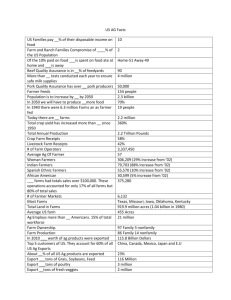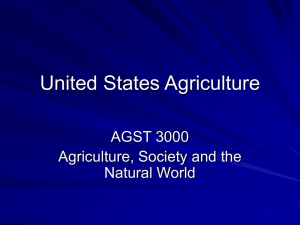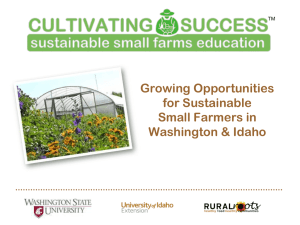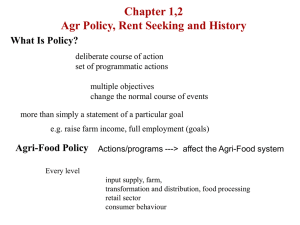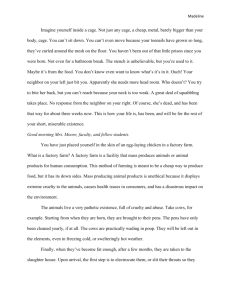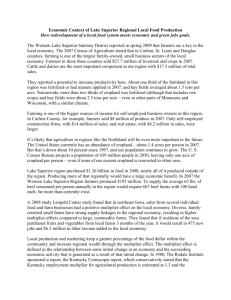Why Livestock Matters - Kentucky Department of Agriculture
advertisement
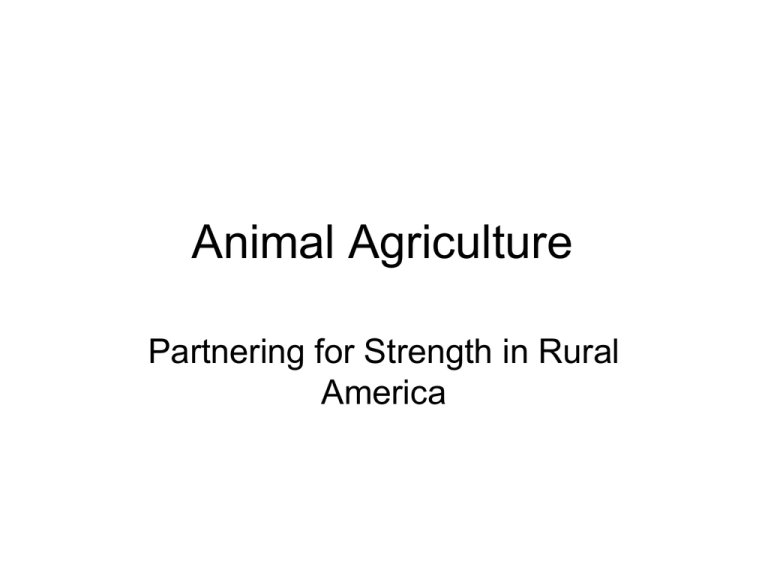
Animal Agriculture Partnering for Strength in Rural America “The Good Old Days” ’57 Chevy – a classic Driven one lately? “The Good Old Days” • • • • • • No power steering No a/c No seat belt No air bags Bad gas mileage No emissions controls Then and now 1950 • U.S. pop. 154 million • 5.6 million farms • 1 farmer fed 30 people 2010 • U.S. pop. 308 million • 2 million farms • 1 farmer feeds 155 people Today’s Farms • GPS Systems • New Production Systems • Safety from farm gate to dinner plate Today’s Farms • • • • New technology Safer food system Increased productivity Environmentally-friendly Agriculture has Changed • • • • • Bigger farms Profitability Increased demand New technologies Ethical commitment unchanged Agriculture has Changed Agriculture has Changed More with less • Compared to 1950, farmers today produce: – 176% more pork per sow with 44% fewer sows – 81% more chicken per bird – 333% more corn on 11% fewer acres – 53% more eggs with 3% fewer hens – 11 times more soybeans on 5 times fewer acres – 69% more wheat on 6% fewer acres – 63% more milk with 58% fewer cows Protecting the Environment • • • • • • Farmers are the original recyclers Manure as fertilizer nothing new Sustainable Cycle Strict regulatory oversight Evolving technologies Good management = minimal odor Pens with Roofs Safety starts in the barn Safe Animals = Safe Food • When most animals were raised outdoors, bad weather, disease and predators took their toll • Animals indoors are healthier and less stressed “Food safety and animal comfort are a point of pride for my family’s farm . I wish people could appreciate the positive difference today from the way hogs were raised 20 years ago.” – Verified by saliva testing for stress reactions Environmental Quality, Sustainability • Controlled environment protects air and water • Today’s manure systems mean less fertilizers Maurice Heard hog farmer Rockfield, KY Manure management technologies, fertilizer generation “Factory Farm” myths Raising farm animals in confinement is cruel: • Most food animals are housed in barns to protect their health and welfare. • Housing protects animals from predators, disease and weather extremes. • Housing makes breeding and birth less stressful, protects young animals and makes it easier for farmers to care for both healthy and sick animals. “Factory Farm” myths Raising farm animals in confinement is cruel: • Modern food animal housing is well ventilated, temperature-controlled, well-lighted, clean and scientifically designed for the specific needs of the animal, such as the regular availability of fresh water and a nutritionally balanced diet. • A hog barn wouldn't be used for cows, any more than an adult would sleep in a child's crib. Housing is designed to allow the farmer to provide the best animal care. “Factory Farm” myths Raising farm animals in confinement is unhealthy: • Animal scientists, veterinarians and on-farm experience show animals kept in housing are no more likely to get sick than in other production systems. • Many would argue they are healthier because they are protected. “Factory Farm” myths Raising farm animals in confinement is unhealthy: • To prevent illness and ensure that animals remain healthy, farmers take preventive measures -including the use of animal health products. • These products are given to the animal in a scientifically formulated feed best suited to the animal's needs. • All animal health products are approved and regulated by the U.S. Food & Drug Administration (FDA) prior to being given to animals. “Factory Farm” myths Farming is controlled by uncaring corporations: • 87% of the 2.2 million farms in the U.S. are owned by individuals or a married couples responsible for operating the farm. • If partnerships – typically a parent and one or more children or other close relatives – are added to this total, 97 percent of U.S. farms are family-owned and operated. • Even those farms that are legally corporations are generally family controlled. There are only 7,000 non-familycontrolled corporate farms in the U.S. Kentucky farmers want you to know • We’re family farms, not factories. • The land is our legacy. • Animal care and food safety are our livelihood. Aaron & Celeste Harned Curt & Carrie Divine Ron & Heather Davis Paducah, KY Morganfield, KY Brewers, KY Kentucky agriculture 85 thousand farms - 13 million acres National Rankings of Ky. Commodities CROPS RANK Corn 14 Soybeans 16 Tobacco 1 LIVESTOCK RANK Poultry 7 Beef cows 8 Hogs 19 Dairy cows 26 CASH RECEIPTS RANK CROPS 28 LIVESTOCK 16 TOTAL 23 USDA NASS 2007 Census of Agriculture $3.9 billion annual impact 32 thousand Kentucky jobs (and we’re not talking horses) June 2010 - Promar International Animal Agriculture Economic Analysis: Kentucky, 1999-2009 Animal Agriculture Matters • • • • • • Affordable food One farmer feeds 144 people Vast majority of farms are family-owned $2.4 billion in property taxes nationwide $16 billion in income & sales taxes 2.5 million jobs Today’s Farms Doing the “right thing” “Proving it”


